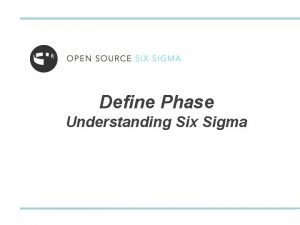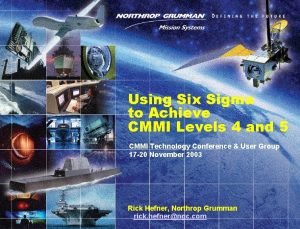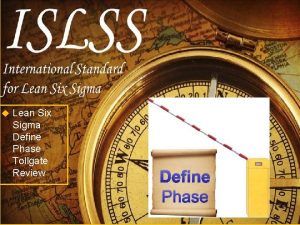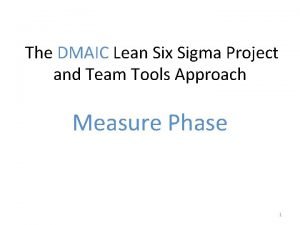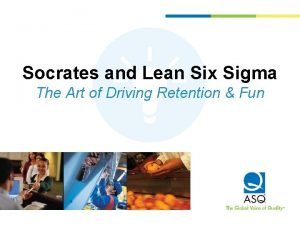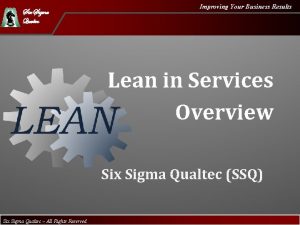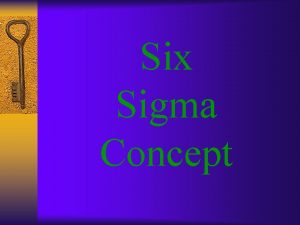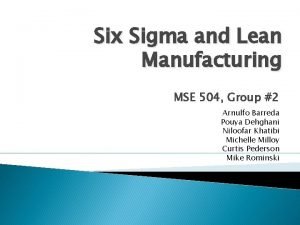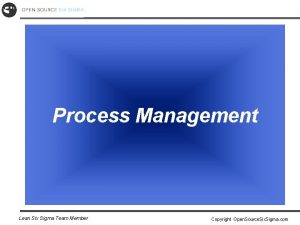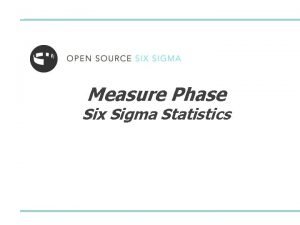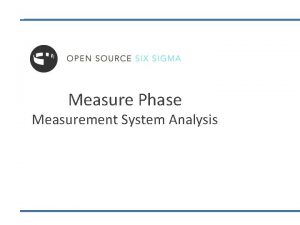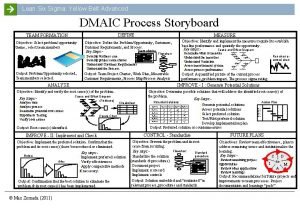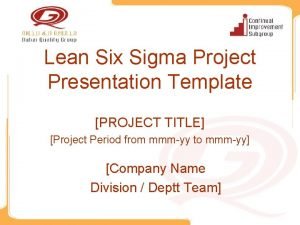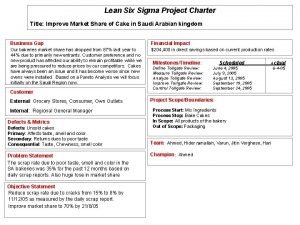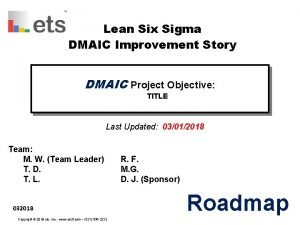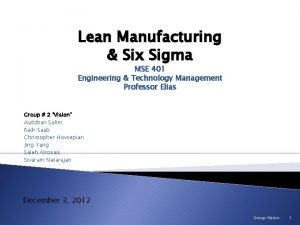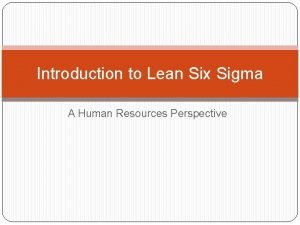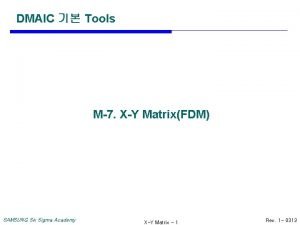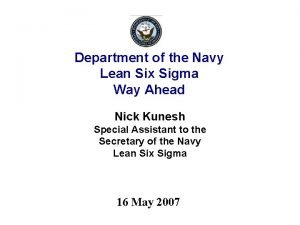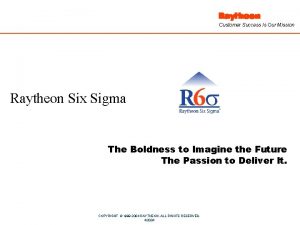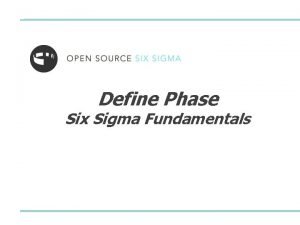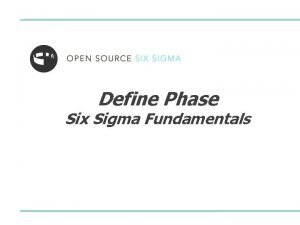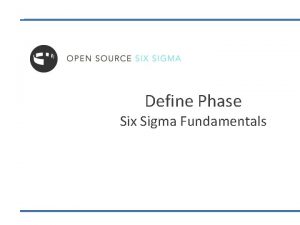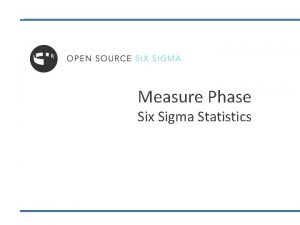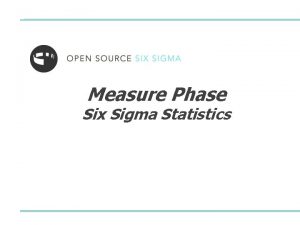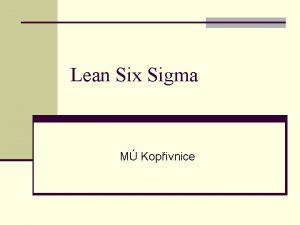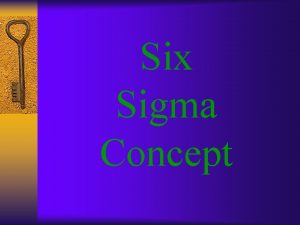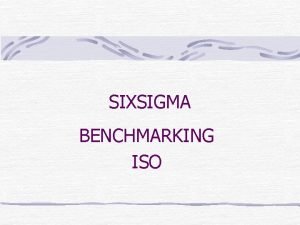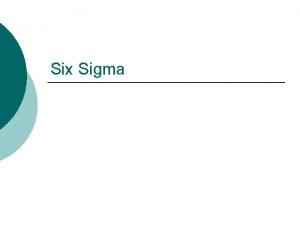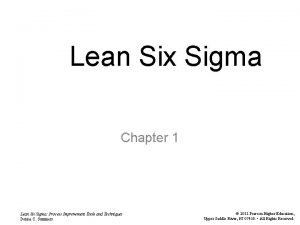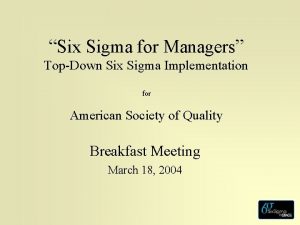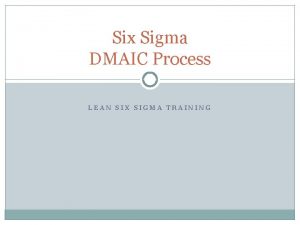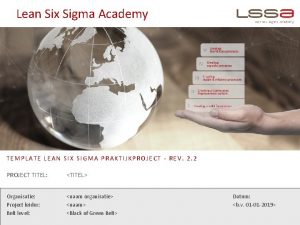Define Phase Understanding Six Sigma What is Six






































- Slides: 38

Define Phase Understanding Six Sigma

What is Six Sigma? Understanding Six Sigma Definitions History Strategy Problem Solving Roles & Responsibilities Six Sigma Fundamentals Selecting Projects Elements of Waste Wrap Up & Action Items 2

What is Six Sigma…as a Symbol? σ, sigma, is a letter of the Greek alphabet. – Mathematicians use this symbol to signify Standard Deviation, an important measure of variation. – Variation designates the distribution or spread about the average of any process. Narrow Variation Wide Variation The variation in a process refers to how tightly all the various outcomes are clustered around the average. No process will produce the EXACT same output each time. 3

What is Six Sigma…as a Value? Sigma is a measure of deviation. The mathematical calculation for the Standard Deviation of a population is: By definition, the Standard Deviation is the distance between the Mean and the point of inflection on the Normal curve. Sigma can be used interchangeably with the statistical term Standard Deviation is the average distance of data points away from the Mean in a distribution. 4 Point of Inflection

What is Six Sigma…as a Measure? The probability of creating a defect can be estimated and translated into a “Sigma” level. *LSL – Lower Spec Limit *USL – Upper Spec Limit 6 5 4 3 2 1 +1 +2 +3 +4 +5 +6 The higher the sigma level, the better the performance. Six Sigma refers to a process having 6 Standard Deviations between the average of the process center and the closest specification limit or service level. 5

Measure “Sigma Level” is: – A statistic used to describe the performance of a process relative to the specification limits – The number of Standard Deviations from the Mean to the closest specification limit of the process USL 6 Sigma 5 Sigma 4 Sigma 3 Sigma 2 Sigma 1 Sigma The likelihood of a defect decreases as the number of Standard Deviations that can be fit between the Mean and the nearest spec limit increases. 6

What is Six Sigma…as a Metric? Each of these metrics serves a different purpose and may be used at different levels in the organization to express the performance of a process in meeting the organization’s (or customer’s) requirements. We will discuss each in detail as we go through the course. • Defects per unit (DPU) • Parts per million (PPM) • Defects per million opportunities (DPMO) • Rolled Throughput yield (RTY) • First Time Yield (FTY) • Sigma (s) 20 18 16 14 12 10 8 0 20 40 60 80 100 These are certain metrics that we use in Six Sigma. You will learn more about these through the course of your study. 7

What is Six Sigma…as a Benchmark? Yield PPMO COPQ Sigma 99. 9997% 3. 4 <10% 6 99. 976% 233 10 -15% 5 99. 4% 6, 210 15 -20% 4 93% 66, 807 20 -30% 3 65% 308, 537 30 -40% 2 50% 500, 000 >40% 1 World Class Benchmarks 10% GAP Industry Average 10% GAP Non Competitive Source: Journal for Quality and Participation, Strategy and Planning Analysis What does 20 - 40% of Sales represent to your Organization? 8

What is Six Sigma…as a Method? DMAIC provides the method for applying the Six Sigma philosophy in order to improve processes. 9 § Define - the business opportunity § Measure - the process current state § Analyze § Improve - eliminate waste and variation § Control - determine Root Cause or Y= f (x) - evidence of sustained results

What is Six Sigma…as a Tool? Six Sigma contains a broad set of tools, interwoven in a business problem-solving methodology. Six Sigma tools are used to scope and choose projects, design new products and processes, improve current processes, decrease downtime and improve customer response time. Six Sigma has not created new tools, it has simply organized a variety of existing tools to create flow. Customer Value Responsiveness, Cost, Quality, Delivery 10 = Management Product Process System EBIT, (Enabler) , Design , Yield , Speed , Uptime , Functional Support

What is Six Sigma…as a Goal? 5+ Sigma 3 - 5 Sigma 3 Sigma 1 - 2 Sigma 11 Sweet Fruit Design for Six Sigma Bulk of Fruit Process Characterization and Optimization Low Hanging Fruit Basic Tools of Problem Solving Ground Fruit Simplify and Standardize

What is Six Sigma…as a Philosophy? General Electric: First, what it is not. It is not a secret society, a slogan or a cliché. Six Sigma is a highly disciplined process that helps us focus on developing and delivering near-perfect products and services. The central idea behind Six Sigma is that if you can measure how many "defects" you have in a process, you can systematically figure out how to eliminate them and get as close to "zero defects" as possible. Six Sigma has changed the DNA of GE — it is now the way we work — in everything we do and in every product we design. Honeywell: Six Sigma refers to our overall strategy to improve growth and productivity as well as a measurement of quality. As a strategy, Six Sigma is a way for us to achieve performance breakthroughs. It applies to every function in our company, not just those on the factory floor. That means Marketing, Finance, Product Development, Business Services, Engineering and all the other functions in our businesses are included. Lockheed Martin: We’ve just begun to scratch the surface with the cost-saving initiative called Six Sigma and already we’ve generated $64 million in savings with just the first 40 projects. Six Sigma uses data gathering and statistical analysis to pinpoint sources of error in the organization or products and determines precise ways to reduce the error. 12

History of Six Sigma • 1984 Bob Galvin of Motorola edicted the first objectives of Six Sigma – 10 x levels of improvement in service and quality by 1989 – 100 x improvement by 1991 – Six Sigma capability by 1992 – Bill Smith, an engineer from Motorola, is the person credited as the father of Six Sigma • 1984 Texas Instruments and ABB Work closely with Motorola to further develop Six Sigma • 1994 Application experts leave Motorola • 1995 Allied. Signal begins Six Sigma initiative as directed by Larry Bossidy – Captured the interest of Wall Street • 1995 General Electric, led by Jack Welch, began the most widespread undertaking of Six Sigma even attempted • 1997 To present Six Sigma spans industries worldwide 13

History of Six Sigma • Simplistically, Six Sigma was a program that was generated around targeting a process Mean (average) six Standard Deviations away from the closest specification limit. • By using the process Standard Deviation to determine the location of the Mean the results could be predicted at 3. 4 defects per million by the use of statistics. • There is an allowance for the process Mean to shift 1. 5 Standard Deviations. This number is another academic and esoteric controversial issue not worth debating. We will get into a discussion of this number later in the course. 14

History of Six Sigma • Six Sigma created a realistic and quantifiable goal in terms of its target of 3. 4 defects per million operations. It was also accompanied by a methodology to attain that goal. • That methodology was a problem solving strategy made up of four steps: measure, analyze, improve and control. • When GE launched Six Sigma they improved the methodology to include the Define Phase. Define GENERAL ELECTRIC 15 Measure Analyze MOTOROLA Improve Control

Champion/ Process Owner DMAIC Phases Roadmap Identify Problem Area Define Determine Appropriate Project Focus Estimate COPQ Control Improve Analyze Measure Charter Project 16 Assess Stability, Capability, and Measurement Systems Identify and Prioritize All X’s Prove/Disprove Impact X’s Have On Problem Identify, Prioritize, Select Solutions Control or Eliminate X’s Causing Problems Implement Solutions to Control or Eliminate X’s Causing Problems Implement Control Plan to Ensure Problem Does Not Return Verify Financial Impact

Define Phase Deployment Business Case Selected Notify Belts and Stakeholders Create High-Level Process Map Determine Appropriate Project Focus (Pareto, Project Desirability) Define & Charter Project (Problem Statement, Objective, Primary Metric, Secondary Metric) N Estimate COPQ Approved Project Focus Recommend Project Focus Y Create Team Charter Team Ready for Measure 17

Define Phase Deliverables Listed here are the type of Define Phase deliverables that will be reviewed by this course. By the end of this course, you should understand what would be necessary to provide these deliverables in a presentation. – – – – – 18 Charter Benefits Analysis Team Members (Team Meeting Attendance) Process Map – high level Primary Metric Secondary Metric(s) Lean Opportunities Stakeholder Analysis Project Plan Issues and Barriers

Six Sigma Strategy Six Sigma places the emphasis on the Process – Using a structured, data driven approach centered on the customer Six Sigma can resolve business problems where they are rooted, for example: • Month end reports • Capital expenditure approval • New hire recruiting Six Sigma is a Breakthrough Strategy – Widened the scope of the definition of quality • includes the value and the utility of the product/service to both the company and the customer. Success of Six Sigma depends on the extent of transformation achieved in each of these levels. 19

Conventional Strategy Conventional definitions of quality focused on conformance to standards. Requirement or LSL Bad Target Good Requirement or USL Bad Conventional strategy was to create a product or service that met certain specifications. • Assumed that if products and services were of good quality. then their performance standards were correct. • Rework was required to ensure final quality. • Efforts were overlooked and unquantified (time, money, equipment usage, etc). 20

Problem Solving Strategy The Problem Solving Methodology focuses on: • Understanding the relationship between independent variables and the dependent variable. • Identifying the vital few independent variables that effect the dependent variable. • Optimizing the independent variables so as to control our dependent variable(s). • Monitoring the optimized independent variable(s). There are many examples to describe dependant and independent relationships. • We describe this concept in terms of the equation: • This equation is also commonly referred to as a transfer function Y=f (Xi) This simply states that Y is a function of the X’s. In other words Y is dictated by the X’s. 21

Example Y=f (Xi) Which process variables (causes) have critical impact on the output (effect)? Crusher Yield Time to Close =f( Feed , Speed , Material Type , Tool Wear , , ) , ) Correct Trial Sub Credit Entry Balance Accounts Memos Mistakes Xn Applied , , If we are so good at the X’s why are we constantly testing and inspecting the Y? 22 Lubricant ,

Y=f(X) Exercise: Consider establishing a Y = f(X) equation for a simple everyday activity such as producing a cup of espresso. In this case our output, or Y, is espresso. Espresso 23 =f( , X 1 X 2 , X 3 , X 4 , Xn )

Six Sigma Strategy We use a variety of Six Sigma tools to help separate the “vital few” variables effecting our Y from the “trivial many. ” Some processes contain many, many variables. However, our Y is not effected equally by all of them. By focusing on the vital few we instantly gain leverage. (X 1) (X 10) (X 8) (X 7) (X 3) (X 5) (X 9) Archimedes said: “ Give me a lever big enough and fulcrum on which to place it and I shall move the world. ” (X 2) Archimedes not shown actual size! 24 (X 6) (X 4)

Breakthrough Strategy Bad 6 -Sigma Breakthrough UCL Performance Old Standard LCL UCL New Standard LCL Good Time Juran’s Quality Handbook by Joseph Juran By utilizing the DMAIC problem solving methodology to identify and optimize the vital few variables we will realize sustainable breakthrough performance as opposed to incremental improvements or, even worse, temporary and non-sustainable improvement. 25

VOC, VOB, VOE The foundation of Six Sigma requires Focus on the voices of the Customer, the Business and the Employee which provides: – Awareness of the needs that are Critical to the Quality (CTQ) of our products and services – Identification of the gaps between “what is” and “what should be” – Identification of the process defects that contribute to the “gap” – Knowledge of which processes are “most broken” – Enlightenment as to the unacceptable Costs of Poor Quality (COPQ) VOC is Customer Driven VOB is Profit Driven VOE is Process Driven 26

Six Sigma Roles and Responsibilities There are many roles and responsibilities for successful implementation of Six Sigma. MBB • Executive Leadership • Champion/Process Owner Black Belts • Master Black Belt Green Belts • Green Belt Yellow Belts • Black Belt • Yellow Belt Eventually there should be a big base of support internal to the organization. 27

Executive Leadership Not all Six Sigma deployments are driven from the top by Executive Leadership. The data is clear, however, that those deployments that are driven by executive management are much more successful than those that aren’t. • Makes decision to implement the Six Sigma initiative and develop accountability method • Sets meaningful goals and objectives for the corporation • Sets performance expectations for the corporation • Ensures continuous improvement in the process • Eliminates barriers 28

Champion/Process Owner Champions identify and select the most meaningful projects to work on, they provide guidance to the Six Sigma belt and open the doors for the belts to apply the process improvement technologies. • Own project selection, execution control, implementation and realization of gains • Own Project selection • Obtain needed project resources and eliminates roadblocks • Participate in all project reviews • Ask good questions… • One to three hours per week commitment 29

Master Black Belt MBB should be well versed with all aspects of Six Sigma, from technical applications to Project Management. MBBs need to have the ability to influence change and motivate others. • Provide advice and counsel to Executive Staff • Provide training and support – In class training – On site mentoring • Develop sustainability for the business • Facilitate cultural change 30

Black Belts are application experts and work projects within the business. They should be well versed with The Six Sigma Technologies and have the ability to drive results. • Project team leader • Facilitates DMAIC teams in applying Six Sigma methods to solve problems • Works cross-functionally • Contributes to the accomplishment of organizational goals • Provides technical support to improvement efforts 31

Green Belts are practitioners of Six Sigma Methodology and typically work within their functional areas or support larger Black Belt Projects. • Well versed in the definition & measurement of critical processes – • Typically works project in existing functional area • Involved in identifying improvement opportunities • Involved in continuous improvement efforts – • Applying basic tools and PDCA Team members on DMAIC teams – 32 Creating Process Control Systems Supporting projects with process knowledge & data collection

Yellow Belts apply the Six Sigma Methodology to their own work responsibilities and serve on project teams. • Provide support to Black Belts and Green Belts as needed • May be team members on DMAIC teams – Supporting projects with process knowledge and data collection 33

The Life of a Six Sigma Belt Training as a Six Sigma Belt can be one of the most rewarding undertakings of your career and one of the most difficult. • You can expect to experience: – – – – Hard work (becoming a Six Sigma Belt is not easy) Long hours of training Be a change agent for your organization Work effectively as a team leader Prepare and present reports on progress Receive mentoring from your Master Black Belt Perform mentoring for your team members ACHIEVE RESULTS! You’re going places! 34

Black & Green Belt Certification To achieve certification, Belts typically must: • Complete all course work: • Demonstrate application of learning to training project: • Must complete two projects within one year from beginning of training • Achieve results and make a difference • Submit a final report which documents tool understanding and application as well as process changes and financial impact for each project 35 – Be familiar with tools and their application – Practice using tools in theoretical situations – Discuss how tools will apply to actual projects – Use the tools to effect a financially measurable and significant business impact through their projects – Show ability to use tools beyond the training environment

Organizational Behaviors All players in the Six Sigma process must be willing to step up and act according to the Six Sigma set of behaviors. – Leadership by example: “walk the talk” – Encourage and reward individual initiative – Align incentive systems to support desired behaviors – Eliminate functional barriers – Embrace “systems” thinking – Balance standardization with flexibility 36

Summary At this point, you should be able to: • Describe the objectives of Six Sigma • Describe the relationship between variation and sigma • Recognize some Six Sigma concepts • Recognize the Six Sigma implementation model • Describe the general roles and responsibilities in Six Sigma 37

The Certified Lean Six Sigma Yellow Belt Assessment The Certified Lean Six Sigma Yellow Belt (CLSSYB) tests are useful for assessing a Yellow Belt’s knowledge of Lean Six Sigma. The CLSSYB can be used in preparation for the ASQ or IASSC Certified Six Sigma Yellow Belt exam or for any number of other certifications, including private company certifications. The Lean Six Sigma Yellow Belt Course Manual Open Source Six Sigma Course Manuals are professionally designed and formatted manuals used by Belt’s during training and for reference guides afterwards. The OSSS manuals complement the OSSS Training Materials and consist of slide content, instructional notes data sets and templates. Get the latest products at… www. Open. Source. Six. Sigma. com
 Voc vob voe
Voc vob voe Kanban six sigma phase
Kanban six sigma phase Sigma sigma phi vcom
Sigma sigma phi vcom Edward via college of osteopathic medicine auburn
Edward via college of osteopathic medicine auburn Normal phase vs reverse phase chromatography
Normal phase vs reverse phase chromatography M tswett pronunciation
M tswett pronunciation Mobile phase and stationary phase
Mobile phase and stationary phase What is mobile and stationary phase
What is mobile and stationary phase Normal phase vs reverse phase chromatography
Normal phase vs reverse phase chromatography Line vs phase voltage
Line vs phase voltage Detectors used in hplc
Detectors used in hplc In a triangle connected source feeding a y connected load
In a triangle connected source feeding a y connected load Broad phase vs narrow phase
Broad phase vs narrow phase Cmmi six sigma
Cmmi six sigma Microsoft six sigma
Microsoft six sigma Tollgate lean
Tollgate lean Six sigma data types
Six sigma data types Who is this
Who is this Six sigma qualtec
Six sigma qualtec Lean six sigma forum
Lean six sigma forum Six sigma 99
Six sigma 99 Mse six sigma
Mse six sigma Lean storyboard
Lean storyboard Six sigma belts hierarchy
Six sigma belts hierarchy Statistics symbols cheat sheet
Statistics symbols cheat sheet Measurement system analysis six sigma
Measurement system analysis six sigma Dmaic yellow belt
Dmaic yellow belt Pilot plan template six sigma
Pilot plan template six sigma Charter lean six sigma
Charter lean six sigma Dmaic tools
Dmaic tools Ceinture jaune lean six sigma
Ceinture jaune lean six sigma Mse six sigma
Mse six sigma Kaizen total quality management
Kaizen total quality management Kpiv six sigma
Kpiv six sigma Lean six sigma hr
Lean six sigma hr Sony six sigma
Sony six sigma Xy diagram six sigma
Xy diagram six sigma Navy lean six sigma
Navy lean six sigma Raytheon six sigma
Raytheon six sigma
